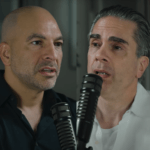Check out more content from Nir Barzilai, M.D:
- (Jan 7, 2019) #35 – Nir Barzilai, M.D.: How to tame aging
- (August 10, 2020) #123 – Joan Mannick, M.D. & Nir Barzilai, M.D.: Rapamycin and metformin—longevity, immune enhancement, and COVID-19
- (April 25, 2022) #204 – Centenarians, metformin, and longevity
In this episode, Joan and Nir discuss their extensive research into rapamycin (including the category of analogs to rapamycin known as rapalogs) and metformin, respectively. Based on his work with metformin, Nir shares how he believes it could be a pro-longevity drug and the clinical trial he’s leading to test this belief. Joan discusses her work with rapalogs, their ability to suppress the immune system as well as provide immune-enhancement, and the clinical trials she has led that inform her insights. We also talk about the potential beneficial roles of both metformin and rapamycin in reducing mortality from COVID-19, reducing the risk of neurodegenerative diseases, and delaying aging as well as its related diseases.
Subscribe on: APPLE PODCASTS | RSS | GOOGLE | OVERCAST | STITCHER
We discuss:
- Joan’s career, interest in aging, and work with rapamycin analogs [3:45];
- When Nir became convinced metformin could be a pro-longevity agent [15:00];
- How metformin and rapamycin impact the hallmarks of aging and extend lifespan [24:15];
- Enhancing the immune system with rapalogs and metformin [34:15];
- Potential of metformin and rapamycin in reducing mortality from COVID-19 [41:30];
- Insights from Joan’s studies investigating the immune-enhancing effects of rapalogs [59:30];
- Vaccines and treatments strategies for COVID-19, and the likelihood of long-term immunity [1:08:15];
- The potential role of rapalogs and metformin in neurodegenerative disease [1:14:30];
- Nir’s TAME trial—primary objectives and latest updates [1:18:00];
- Potential synergistic effect when combining metformin with rapamycin [1:25:45];
- Why Peter stopped taking metformin and started taking rapamycin [1:27:30];
- Story from Nir’s book that demonstrates the challenge of doing good scientific studies [1:37:30];
- The biology of aging—epigenetic clocks, proteomics, and Nir’s centenarian data [1:42:00];
- Joan’s dream experiment to test immune-enhancing effect of RTB101 [1:57:15];
- Concluding thoughts on COVID-19 [1:59:45]; and
- More.
Joan’s career, interest in aging, and work with rapamycin analogs [3:45]
Early career
- Started career in academic medicine after training in infection disease
- She was running a basic science lab when she had a transformative moment—
- She read a review by Cynthia Kenyon in which she pointed out that genetic mutations in worms that cause doubling of lifespan suggests that organisms have the capacity to live longer than they normally do
“I just thought that was the coolest piece of research and the coolest idea that sort of threw medicine on its head.” —Joan Mannick
Foray into aging research
- She began doing aging research in her lab after that
- Eventually moved to Novartis in a group called the New Indications Discovery Unit
- Despite reservations at first, Novartis agreed to let Joan “work on aging”
- Novartis already had a rapamycin analog, and there was data that mTOR inhibitors have beneficial effects on aging and lifespan
- Joan thought the immune function was an area where you could see improvement in a relatively short period of time
- In 2014, Joan did a trial giving older adults an mTOR inhibitor to see if they could make their immune function better
Given that the clinical application for rapamycin was immune suppression—what made Joan think that you could actually use the same drug to enhance the immune response to a vaccine?
- Because of all the data that mTOR inhibition has beneficial effects on aging and every organism tested
- The ITP (interventions testing programs) run through NIH showed inhibition of mTOR could extend the life of mice (Harrison et al., 2009; Miller et al., 2011)
- This was enough for Joan to feel that “Someone’s just got to do the trial in humans and see if this is true in humans”
- Knowing that the only way this will ever move forward is if the drug was safe and did not suppress the immune system, they started with a very low dose with intermittent dosing
- They were looking to see if the patients had an enhanced immune response to the flu vaccine
-Study details
- The drug used was RAD001 (a.k.a. everolimus)
- The doses given to the 4 different arms—
- 1) Placebo arm
- 2) 0.5 mgs of RAD001 daily
- 3) 5 mgs once a week
- 4) 20 mgs once a week
- The goal was to partially inhibit mTOR, because when you completely inhibit mTOR, you stop T cells from proliferating and you’ll get immunosuppressed
-The ending observations:
-
- The two lower doses (0.5 mgs daily and 5 mgs once a week) were the best
- Turning mTOR down (not off) in the elderly is the best for enhancing immune function
When Nir became convinced metformin could be a pro-longevity agent [15:00]
- The normal clinical indication of metformin is an early-line treatment for patients with type 2 diabetes
- While at Yale doing his first postdoc with Ralph DeFronzo, Nir spent the year looking for the mechanism of action of metformin (which wasn’t yet being used in the US)
- In 1991, Nir’s study was the first to show that metformin specifically targets hepatic glucose production — aka the insulin sensitivity of the liver much more so than the muscle
- Metformin finally began gaining more interest in the US after the DPP found metformin was people from developing diabetes
- There were also many association studies with all kinds of cancer as well as Alzheimer’s disease and MCI
- The turning point for Nir came when he read a paper showing that people on metformin, even those who were diabetic and obese, had less mortality when compared to control patients without diabetes who were not taking metformin
⇒ Nir’s 2016 paper talking about the UKPDS and DPP papers: Metformin as a Tool to Target Aging
“And all of a sudden we have everything. We have all ages, all the old age-related disease, clinical association studies, we’d have mortality. That just made metformin the perfect tool for us to push geroscience ahead.” —Nir Barzilai
ITP studies
What is the ITP?
{end of show notes preview}






All these scientific experiments could be shortened if you go to areas that have centenarians. Dominica, NW Costa Rica. Just ask indigenous people why they live longer! They say it’s because their food is pesiticide free soil filled with microbiomes, eating fresh food, no junk food! Gosh what an easy answer. Maybe too easy for scientists! My mom lived to be 100. Why? She ate fresh food, limited amounts of food, no sugar, no white flour, no junk! Didn’t have much money, but completely content with life. Slept 8 hours. A Happy Person!
Did she eat food from animals? I’m very interested in centenarians who indeed eat/ate animal products in a regular basis!
I am 66 year old female who is athletic, very healthy nutrition, and optimal lifestyle. Formerly did research with Burroughs Wellcome and SmithKline. I am taking low dose met form in and other anti-aging protocols. I would be very interested in participating in one of your clinical trials. Hope to hear from you. Thanks
Rapamycin has significant negative renal effects. Yes? Not sure of my use until we have valid DBPC trials. Thanks, tom md.
Yes, Peter, please talk about side effects every time you put drugs on the table! What are the potential side effects of Metformin, Berberine and Rapalogs? You always talk about then as fantastic tools but never talk about possible side effects! Longo has said he would never take Rapalogs nor Metformin due to their potential side effects!
I get more and more surprised after every episode on why you have not interviewed Dr. Valter Longo yet! Attia dialog with Longo is literally something the world needs! Please invite him soon!
Dr Attia, vis-a-vis your conjecture that metformin (possibly) has no benefit for a maximum exerciser — are there any benefits of metformin or rapalogs that we think periodic multi-day water fasting does not confer? That is, if a person is doing X days of water fasting every Y weeks (imagine ideal dose values for X and Y) would metformin and/or rapalogs confer any benefit for this person or are the drugs only helpful for the average western lifestyle?
When are we going to see funding for studies thab begin to answer the question of “what benefits do various doses of fasting confer”?
I see that mental health uses of psycodelics are finally getting research funding. How about fasting research next?
Fasting was not invented by Longo nor any other white-robe doctor/scientist. Fasting has a long tradition an development since centuries ago! Maybe it would be easier and faster to recover that knowledge rather than waiting for some other white-robe to come and tell us about their lab results and the optimal X-Y.
“The turning point for Nir came when he read a paper showing that people on metformin, even those who were diabetic and obese, had less mortality when compared to control patients without diabetes who were not taking metformin”.
First, you linked the wrong paper: the linked paper is from the UKPDS study, in which all patients were diabetic. I’m pretty sure you meant this one:
https://dx.doi.org/10.1111/dom.12354
There was a fatal flaw in this paper (and there are similar problems in the design of nearly all other papers purporting to show better outcomes in metformin-treated patients, especially when compared to the general population): a form of survivors’ bias. As soon as metformin-treated subjects’ diabetes progressed to the point where another drug was added, they were censored out of the metformin-treated group — in other words, progressively enriching the remaining metformin-treated group with healthier and healthier people, compared to the general population that is stably composed of the same people and that only gets sicker (due to aging). See:
https://www.sciencemediacentre.org/expert-reaction-to-study-looking-at-type-2-diabetes-metformin-and-lifespan/
https://hypothes.is/search?q=tag%3APubMedCommonsArchive+25041462
Dr. Barzilai said that diabetic patientswho were taking metformin immunized better against the flu. However, the press report you guys link, and the underlying study:
https://www.ncbi.nlm.nih.gov/pmc/articles/pmid/19494812/
… are about a MOUSE study. I can find no human study finding that metformin enhances vaccine response in humans: in fact, the only study I can find found that “a *delayed* response in the [haemagglutination-inhibition] titre against the influenza B antigen, wherein the maximum response was recorded at 90 days instead of 30 days post-vaccination in [diabetic] patients prescribed metformin or glibenclamide” and that these drugs *suppressed* the avidity of the antibodies raised upon immunization, and that metformin *suppresses* the interferon response to immunization (with inconsistent results for glibenclamide)— the same defect that Dr. Mannick thinks is targeted by mTOR inhibitors to enhance immune response. “Reduced IFN-α expression via decreased mTORC1 signalling in individuals with T2DM who were prescribed metformin may lead to reduced selection of germinal centres and affinity maturation.”
https://www.nature.com/articles/s41598-020-60213-0
I stand corrected on that last comment: there is a study finding better B-cell response to vaccination in early diabetic subjects treated vs. untreated with diabetics (although it is not a randomized study):
https://www.ncbi.nlm.nih.gov/pmc/articles/PMC5560851/
“A paper from China looked at 283 diabetic patients with COVID-19
104 of them came to the hospital already taking metformin
179 of them were not taking metformin
Just 2.9% of people on metformin died versus 12.3% of the to no-metformin group who died”
A new “retrospective study in a cohort of 1,213 hospitalized individuals with COVID-19 and pre-existing T2D indicated that metformin use was significantly associated with a higher incidence of acidosis, particularly in cases with severe COVID-19, but *not* with 28-day COVID-19-related mortality.” The full text makes it clear that this actually means all-cause mortality in their COVID cohort. On the other hand, “metformin use was significantly associated with reduced heart failure and inflammation.” “The incidence of ARDS was also significantly lower in the metformin group compared to the non-metformin groups (adjusted HR, 0.66; 95% CI, 0.46–0.96; p = 0.028) ”
This seems beneficial, but apparently not beneficial enough to save anyone’s life.
They note that “This finding is in agreement with a Korean population-based cohort study, which also showed no significant association was indicated between metformin therapy and 30-day mortality in individuals with ARDS and pre-existing diabetes (Oh and Song, 2020).”
Also, in this study, 678 patients were on metformin, vs. 535 who were not; in commenting on the previous, smaller study, Dr. Barzilai noted that “the use of metformin in China for diabetic people is between 60 and 70% — yet, the most people who were hospitalized [in the earlier study] were NOT using metformin. The implication of this observation is potentially that the diabetics on metformin were less likely to need to go to the hospital (or maybe even get COVID-19 at all).” This new, larger study seems to undermine that speculation.
The link:
https://www.cell.com/cell-metabolism/fulltext/S1550-4131(20)30426-5
OK, so enough zone 2 Exercise beats Metformin for insulin sensitivity, blood glucose control, insulin control and lipids control.
Does exercise beats Rapalogs too for the same metabolic functions involved?
And, for enhancing immunity, fight viral infections, enhance vaccine efficacy, does exercise beats Metformin and Rapalogs too?
Re: Dr. Barzilai’s comments on the MASTERS (progressive resistance training (PRT) ± metformin):
First, “He points out that while the metformin group had less muscle mass growth, the function was actually the same.” Statistically, that’s true, because the results were non-significant, but the raw numbers indicated less gains across the board: “Knee extension 1 repetition maximum (RM) increased 23.1% (SD 18.9) in [PRT+] placebo and 15.3% (SD 18.5) in [PRT+] metformin (between groups p = .055); knee extension isometric strength increased 11.8% (SD 12.7) with placebo compared to 6.7% (SD 14.5) with metformin (between groups p = .082); and peak knee extension power increased 29.4% (SD 40.7) in placebo versus 14.3% (SD 35.7) in metformin (between groups p = .064).”That seems like too consistent an effect to ignore, even if each of them individually didn’t reach p≤.05
Second, he says “In other words, the metformin group is doing better work per gram of muscle compared to the placebo group” (because they gained less mass but supposedly have equal function). But in fact they found the opposite, albeit again NS: “Relative strength (knee extension kg/bilateral thigh muscle mass kg) gains following PRT were similar in both groups, with placebo improving 19.7% (SD 19.0) and metformin improving 14.5% (SD 17.9) (between groups p = .188).”
He then talks about the differences in muscle gene expression in the metformin-treated subjects in his followup study to MASTERS, and speculation that this might indicate an anti-aging effect despite metformin’s impairment of muscle mass gains in response to exercise. First, the paper he’s referring to has now been published (you might put this in the relevant point in the transcript):
https://www.aging-us.com/article/104096/text
Second, his contention that in this context adding MET to resistance training produced a more youthful or anti-aging transcriptome: in the paper itself, the consensus or fight-to-a-truce point of the authors was much more mixed:
—————————————————————
Of the 517 genes that changed exclusively in the metPRT [metformin + progressive resistance training] group, pathway analyses show overrepresentation of aging hallmarks including cellular senescence, and autophagy [38], as well as post-translational modification pathways, specifically neddylation and ubiquitination …; however, it is unclear how changes in gene expression observed here in metPRT might alter the older adult muscle phenotype.
In lieu of our findings that metPRT appeared to affect pathways associated with aging, we performed RNA-sequencing on skeletal muscle biopsies from 21 young individuals (mean age 24, 11 females, 10 males, Supplementary Table 4) under resting conditions and compared their transcriptome to that of week 0 baseline biopsies from the older adult trial participants. Our analysis revealed that 4654 DEG [differentially-expressed genes] were present when comparing baseline biopsies (FDR-adj p-value < 0.01) with 2446 upregulated and 2208 downregulated (Figure 3A and Supplementary Table 5). Following 14 weeks of PRT, the week 16 time point from plaPRT [placebo + PRT] compared to young demonstrated a dramatic decrease in DEG that were previously observed at baseline (2898 DEG), with 1089 new DEG apparent following 14 weeks of plaPRT (Figure 3B and Supplementary Table 5). MetPRT further reduced the number of DEG compared to young muscle to 2705; *however*, the number of unique [i.e., new] DEG that were present after 14 weeks of PRT was also lower compared to placebo (837 DEG), consistent with our initial findings that metformin blunts the *overall* transcriptomic response to PRT (Figure 3B and Supplementary Table 5).
Young vs old baseline DEG that were lost following PRT in both groups (1483) include RNA splicing and numerous genes involved in longevity-associated pathways (Figure 3C and Supplementary Table 6). After identifying DEG between young and old muscle at baseline that were no longer differentially expressed at week 16 in both plaPRT and metPRT, we identified 466 DEG that returned to young expression levels only in metPRT. Pathway overrepresentation analysis showed that these genes were largely involved in metabolism, particularly lipid metabolism (Supplementary Table 7).
—————————————-
A post hoc analysis of a much larger, much longer-term study of the effects of MET on frailty muscle in aging people with prediabetes found "Early [intensive lifestyle] intervention, at an average age of about 50 years, in persons at high risk of diabetes may reduce frailty prevalence in later life. Metformin may be ineffective in reducing frailty prevalence."
The intensive lifestyle intervention was at least 150 minutes per week of moderate-intensity exercise (such as brisk walking — not resistance training) plus a pretty uninspiring diet (based on the 1990s Food Pyramid and the old NCEP Step 1 diet (low in total and saturated fat) — not something you'd expect to have all that strong an effect on frailty. Yet the ILS cut risk of frailty by nearly 40% over a decade, while MET was not different from placebo: "ILS = 3.0%, metformin = 5.4%, placebo = 5.7% at Year 8, and ILS = 3.6%, metformin = 5.3%, placebo = 5.4% at Year 10. Odds ratios (95% CI) estimated with GEE models were ILS versus placebo, 0.62 (0.42–0.93), p = .022; metformin versus placebo, 0.99 (0.69–1.42), p = .976; and ILS versus metformin, 0.63 (0.42–0.94), p = .022. Odds of being frail versus nonfrail were 37% lower for ILS compared to metformin and placebo."
https://academic.oup.com/biomedgerontology/advance-article-abstract/doi/10.1093/gerona/glaa295/6079760
By coincidence, a new report is out from MASTERS today. Key bottom line: “metformin use during PRT blunted density and strength gains by inhibiting fiber type switching primarily in those with low baseline” thigh muscle density — that is, in those who stand the most to gain by increasing strength.
https://link.springer.com/article/10.1007%2Fs11357-020-00315-9